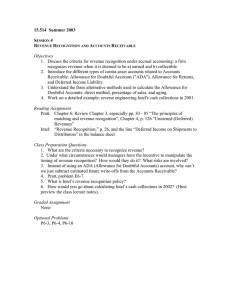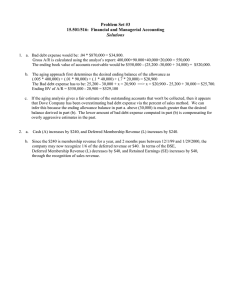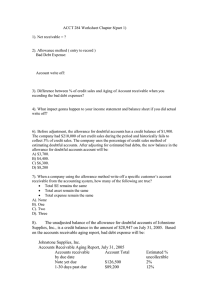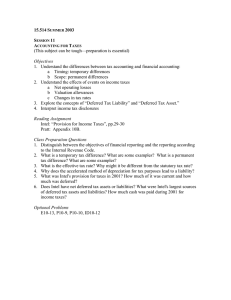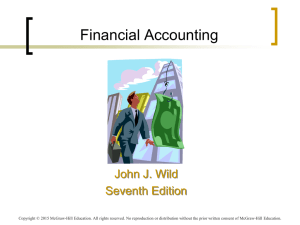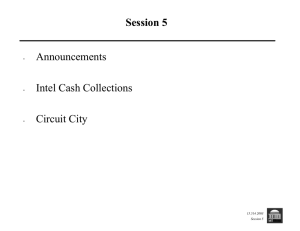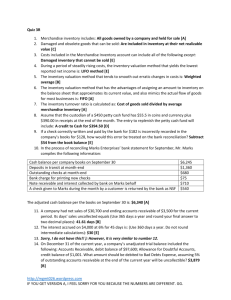Accounting 15.515 Session 4 Revenue Recognition Accounts Receivable Deferred Revenue
advertisement
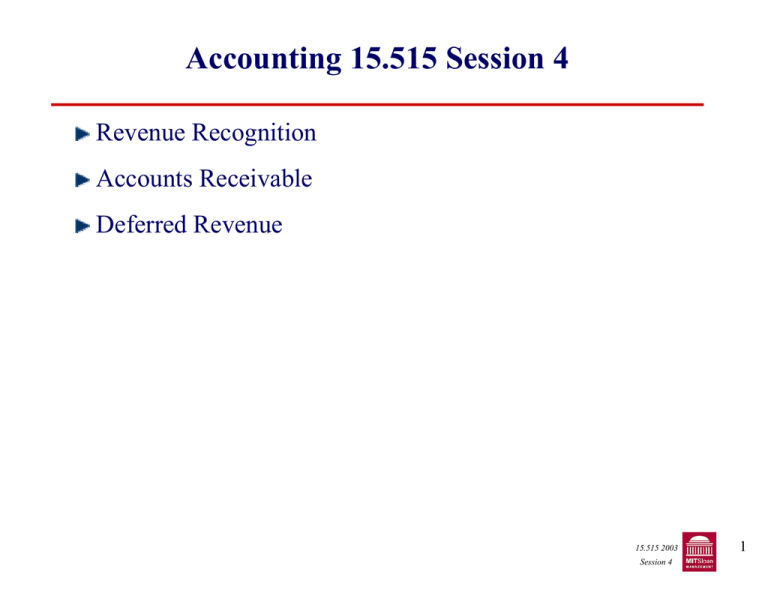
Accounting 15.515 Session 4 Revenue Recognition Accounts Receivable Deferred Revenue 15.515 2003 Session 4 1 Why do we care about revenue recognition? We want to understand how Net Income is computed so we can interpret this performance measure. Revenue is obviously a big part of Net Income Statistical Evidence: over 40% of SEC enforcement actions on accounting issues deal with Revenue Recognition Anecdotal Evidence: Recent experience of Bristol-Myers • "In another setback for the beleaguered drug maker, Bristol-Myers Squibb Co. confirmed that the Securities and Exchange Commission has opened an inquiry into whether it improperly inflated revenue last year by as much as $1 billion through use of sales incentives... Drug makers, like many other manufacturers, can boost near-term sales by extending lower prices to wholesalers, encouraging them to load up. But such "channel-stuffing" hurts later sales." (The Wall Street Journal, 7/12/2002) 15.515 2003 Session 4 2 Criteria for Revenue Recognition Under accrual accounting, a firm recognizes revenue when it has: 1) Performed all, or a substantial portion of, the services to be provided. 2) Incurred a substantial majority of the costs, and the remaining costs can be reasonably estimated. 3) Received either cash, a receivable, or some other asset for which • a reasonably precise value can be measured • collectibility is reasonably assured. 15.515 2003 Session 4 3 Importance of Accounts Receivable Industry Eating Places Family Clothing Stores (The GAP) Race Track Operations Grocery Stores Intel Semiconductors Advertising Agencies Trans. Freight/Cargo Computer Software Wholesale Overall Median Receivables Total Assets 1.6% 3.0 3.1 4.9 8.6 11.3 42.7 43.1 45.5 13.0% Source: 5,933 industrial firms from 2000 Global Vantage 15.515 2003 Session 4 4 Allowance for Bad Debts (Uncollectibles) Methods • Direct Method • Percentage of Sales • Aging How might a firm’s choice of method evolve over time? 15.515 2003 Session 4 5 Balance Sheet Account Formulas and their Income Statement Components Components Accounts Receivable (Asset) -Allowance for doubtful Accounts (Contra Asset) Beginning Balance Beginning Balance + Credit Sales - Cash Collected - Amounts Written Off + Reinstatements +Amounts Recorded as Bad Debt Expense - Amounts Written Off + Reinstatements = Ending Balance = Ending Balance 15.515 2003 Session 4 6 Parallels between Bad Debts and other Accrued Expenses Cash + A/R - ADA Accrue Expense Pay Liability 50 K (50)K (50)K (50)K Accrue Bad Debts Write Off Accounts Acc. Ret. = Liab. + Earn 50 K (50)K (50)K (50)K 15.515 2003 Session 4 7 Problem E6-7 See Problem E6-7 on pages 272-3 of the course textbook. 15.515 2003 Session 4 8 Problem E6-7 (continued) AR -ADA L CC RE BB Sales Write-Off Bad Debt Expense EB 15.515 2003 Session 4 9 Allowance for Returns If customer has the right to return the product, the seller must estimate the dollar value of returns. Revenue is reported net of the amount expected to be returned. Typically, seller sets up a contra-asset account, Allowance for Returns: • Analogous to Allowance for Doubtful Accounts • When return actually occurs, reduce both Allowance and face value of Accounts Receivable (or Cash) by the invoice amount. • Return has no effect on Net Income, nor on Net Assets, just as Write-off of Uncollectible has no effect on these amounts. • BSE: AR - Allowance for Returns = RE Intel takes a slightly different approach: Deferred Income Liability. 15.515 2003 Session 4 10 Deferred Income: An Example Shipments on 3/1 to OEMs and Distributors: $ 350,000 Total Billings: 280,000 70,000 Direct to OEMs COGS: To Distributors (PP) $ 90,000 72,000 Direct to OEMs 18,000 To Distributors (PP) • Return / Price Protection expires for $35K of sales on 3/31 • Invoice Price is reduced from $35K to $25K on the remainder of shipment on 4/15 15.515 2003 Session 4 11 Deferred Income: An Example AR + INV Deferred Income + RE OEM sales Distrib. Sales PP Expires For $35K PP Applies For 35K 15.515 2003 Session 4 12 Reverse Engineering: How much Cash did Intel Collect from Customers in 2002? Reverse Engineering process: Identify Relevant Balance Sheet Accounts: A/R, Allowance for Doubtful Accounts, Deferred Income Identify the activities that affect these accounts: • Recognizing sales revenue as A/R • Recognizing bad debt expense • Writing off uncollectible accounts • Invoicing products that affect the Deferred Income Liability Obtain amounts from the Financial Statements, notes, other • i.e., Intel’s Bad Debt Expense ($10M) and Write-offs ($21) are disclosed in its 10-K report filed with the SEC, but not in the annual report. Set up BSE template and “plug” the remaining numbers 15.515 2003 Session 4 13 Determining Intel’s Cash Collections Cash Begin Balance +AR -ADA +OA =Def Inc 2,675 68 418 2,631 57 475 +RE Sales Revenue Bad Debt Expense WriteOffs Change in Def Inc Cash Collected End Balance 15.515 2003 Session 4 15 Summary Points Criteria for recognizing revenue (Earned and Collectible) Collectibility: Match expected bad debts to the period in which the sales occur - Distinguish between Bad Debt Expense and Write-Offs - Methods for estimating Bad Debts / Uncollectible Accounts Right of Return: match expected returns to the sales period, or more conservatively, defer revenue recognition until return protection / price protection ends Reverse Engineering: infer the activities that underlie a firm’s reported financial results 15.515 2003 Session 4 16
